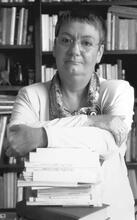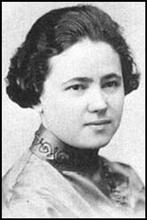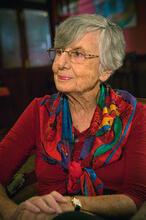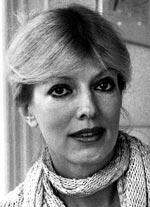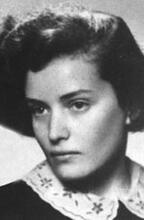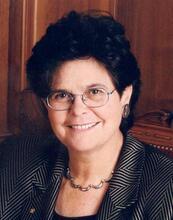Dorothy Schiff
Dorothy Schiff led many lives, from debutante to social reformer, but she is best remembered as the publisher of the New York Post, the first woman to run a New York newspaper. After her first divorce, she used her wealth and influence to become director of the Women’s Trade Union League and support other social causes. In 1939 she bought the ailing Post on the advice of her second husband, who became its publisher, but when the Post continued to struggle, she divorced him and took control of the paper herself in 1942. She turned the Post into a successful, liberal paper, unafraid to criticize political heavyweights Joseph McCarthy and J. Edgar Hoover as well as personal friends like Robert Moses.
Married four times before resuming her maiden name, Dorothy Schiff, owner and publisher of the New York Post newspaper for 37 years, was perhaps most accurately described as “Mrs. Post.” Her publishing philosophy was simple: The Post must avoid “narrow-mindedness, prejudice, and all the things it is the business of liberals to fight.” Her private life was more complex. Besides having four husbands, Schiff was romantically linked with a Rothschild, Serge Obolensky, the Vicomte Sebastien Foy, Averell Harriman, Lord Beaverbrook, Leslie Hore-Belisha, H. G. Wells, and (erroneously, she insisted) Franklin Delano Roosevelt. Revealingly, she once said, “A lot of my life was a search for love—to love and be loved.”
Religion & Early Life
A paradox, Schiff was attractive, socially prominent, and politically influential—but plagued by depression and anxiety. Raised a Jew, she read the New Testament, attended Christian services, and called the bat and bar mitzvah ceremony a rabbi conducted for her and her younger brother her “confirmation.” Received into the Episcopal church before her first marriage, she reverted to Judaism before her second, favored the establishment of Israel but disapproved of her third husband’s support of the Irgun, and visited Israel with her fourth husband—a place that was “grimmer” than she expected but impressive in its dedication to the kibbutz movement.
Schiff was born on March 11, 1903. Her grandfather Jacob Schiff, who had emigrated from Frankfurt in 1865, was a director of Kuhn, Loeb and Co., a founder of Temple Emanu-El, and a devout Jew who visited his grandchildren each Friday to confer Sabbath blessings. He contributed generously to the International Ladies Garment Workers Union because of his concern for Eastern European immigrants and set up Hebrew schools in all five boroughs of New York City. Schiff’s father, Mortimer Schiff—dispatched to a Great Northern road gang to learn the railroad business, and then to Europe to learn banking—preferred racehorses. Her mother, Alice Neustadt, shared her husband’s aversion to German Jews as well as his social aspirations. The couple accepted Jacob Schiff’s wedding gift—a Fifth Avenue mansion—but fled the family enclave for Northwood, the Schiff estate in Oyster Bay, New York. In 1904, they were finally admitted into the social register.
Schiff’s early years were scarred by parental coldness and a lonely education at home, due to her mother’s fear of infection. During her single year at Brearley School, she felt isolated by her wealth and her Jewishness. Nor was she successful during a year at Bryn Mawr, failing every course before she left to prepare for her debut. She studied typing and shorthand, took correspondence courses, and enrolled in the New School University in Exile, but, as she observed years later, she was desperate to be free, and “marriage was the only escape.”
Marriage to Richard B. Hall
At seventeen, she met Richard B. Hall, a salesman who was perennially in debt but was listed in the social register. Despite parental disapproval, she married him in 1923. A son, Morti, was born in 1924 and a daughter, Adele, thirteen months later; but the marriage was doomed. Schiff’s family allowance was twenty times Hall’s salary; even worse, he was a drinker, a philanderer, and an anti-Semite who complained that his wife’s origins barred him from the best clubs. In 1931, when her parents’ deaths within a few months of each other gave her an inheritance of well over fifteen million dollars, Schiff announced, “Dick, I’m rich at last—and now I’m going to divorce you!”
Social Activism
Schiff had already met George Backer, the son of Eastern European immigrants. After a Nevada divorce from Hall, she married him in 1932. On her 300-acre share of the Northwood estate, Schiff built, at the height of the Depression, the mansion where her third child, Sarah-Ann, was born in 1934. Her deepening emotional depression led her into intensive therapy and back to New York City, where she became involved in community and political activities. She attended the 1933 Inaugural Ball and, inspired by President Roosevelt’s speech, expanded her interests. She participated in a Madison Square rally to boycott German goods, became director of the Women’s Trade Union League, joined organizations helping the underprivileged, and was appointed to the Board of Child Welfare.
Introduced to President Roosevelt by his daughter, Anna, Schiff became a frequent guest at Hyde Park, the Roosevelt estate on the Hudson. She was often driven about by FDR in his specially constructed automobile. When he bought an adjoining 90-acre tract, she purchased half at his urging and constructed the modest Red House in a style she dubbed “Franklin the First.”
Purchase of the New York Post
n 1938, Schiff ran for Nassau County delegate to the New York State Constitutional Convention but lost to Robert Moses. The following June, at her husband’s urging, she purchased the Post.
The country’s oldest continuously published daily, the New York Post was founded by Alexander Hamilton in 1801. In 1939, its owner, J. David Stern, was compelled to sell the debt-ridden paper. Backer became president and editor, while Schiff became vice president and treasurer. The feature editor, whom Schiff later promoted to executive editor, was Theodore O. Thackrey, destined to be her third husband. After the change in ownership, the Post continued to lose money and readers—a situation that exacerbated marital conflicts. In 1942, Schiff decided to take over the newspaper, ending both her collaboration and her marriage with Backer. After a 1943 Nevada divorce, she married Thackrey.
The 1940s brought publishing triumphs and personal trials. In 1946, the Post bought the Bronx Home News (circulation: 124,000) and went on to acquire radio and television stations. The Post itself was refurbished with added popular features, syndication services, new columnists, a foreign bureau, a Paris edition (the Paris-Post, published from 1945 to 1948), and a tabloid format. But Schiff suffered a miscarriage in 1944, and her marriage foundered. Thackrey argued that her friendship with the president gave rise to rumors and endangered the Post’s independence. Husband and wife also disagreed politically: In 1948, Thackrey supported Henry Wallace for president, while Schiff, disliking Harry Truman, endorsed Thomas E. Dewey. The couple published their differences in a series of columns. After the election, Schiff attended the United Nations session in Paris. When she returned home to find that Thackrey had written a critique of conservative policy around the world, she forbade him to publish it. In July 1950, they were divorced.
Political Focus at the Post
Thereafter, the Post became Schiff’s primary focus. She cut costs, developed new advertising accounts, and encouraged a wider spectrum of views, supporting her staff’s investigation of Robert Moses (an old friend) and coverage critical of such conservative icons as Walter Winchell, Joseph McCarthy, and J. Edgar Hoover. In September 1951, she began publishing a series of columns on various issues; in the following year, she won election as anti-Tammany candidate for the Democratic State Committee from the Ninth Assembly District. She supported Adlai Stevenson, but her friendship with Nelson Rockefeller caused problems. In 1958, for instance, the Post endorsed Democratic gubernatorial candidate Averell Harriman. But the day before the election, Schiff commandeered the final edition’s front page to rebuke Harriman for calling Rockefeller anti-Israeli. The criticism alienated liberals and Schiff’s longtime friends; later that year, she abandoned the column. Meanwhile, her personal life had entered a new stage. In April 1951, she had met Rudolf G. Sonneborn, a Jewish German industrialist and Zionist from Baltimore. Schiff accompanied him to Israel, and in 1953 announced their marriage in her column. The marriage endured through his slow recovery from a massive stroke in 1959, but in 1965 they were divorced.
The 1960s brought a revival of political attention as Schiff returned to the Democratic fold by endorsing John F. Kennedy. She was a guest at the White House during his administration and after the accession of Lyndon B. Johnson—although she refused the latter’s request to serve as ambassador to Liberia. But Schiff was not impressed with the 1972 Democratic candidate George McGovern, being generally skeptical of reformers. As she confided in a “Dear Reader” column, “Politics doesn’t consist in being right. It’s in making other people think you are.”
Decline of the Post
The 1960s also brought the 114-day newspaper strike that, on December 7, 1962, closed down four New York papers: the New York Times, the Daily News, the World-Telegram, and the Journal-American. In a show of unity, workers at the Herald Tribune, the Mirror, and the Post also went on strike. The Post had weathered a seventeen-day strike in 1958, but it was too small and liberal for a strong voice in the Publisher’s Association, which opposed the strikers, and its financial balance was precarious. Outvoted on critical points and afraid that the strike would hasten the Post’s demise, Schiff resigned from the association and resumed publication. She antagonized her fellow publishers, but the Post seemed secure. It survived, even when the World-Telegram, the Journal-American, and the Herald Tribune merged into the World Journal Tribune in 1966, with a combined circulation of nearly 700,000. Less than a year later, the Post announced that the World Journal Tribune had published its last issue.
To expand production, the Post—now the only evening paper in New York City—purchased automated equipment and moved from West Street to the larger quarters vacated by the Journal-American on South Street. But television had begun to have an effect. By the mid-1970s, the Post was running a deficit, and in December 1976, Schiff announced that the paper had been sold to Rupert Murdoch.
Though her career was not immune to criticism—some people alleged that she confused gossip with political commentary—Schiff had no illusions about her role. “Influence, not power,” she commented, “is what interests me,” and she explained her many invitations in this way: “It’s only because I’m Dorothy Schiff of the New York Post; otherwise I wouldn’t be [there].” Nor did she sentimentalize her devotion to the paper. In an interview shortly before her death on August 30th, 1989, she said “The men I was in love with were in love with someone else, and the men who were in love with me were a nuisance. And so I have given that side of me to things—my newspaper, really. I had to …”
Adler, Cyrus. Jacob H. Schiff: His Life and Letters. Garden City: Doubleday, 1928.
“Dorothy Schiff, 86, Ex-Post Owner, Dies.” NYTimes, August 31, 1989.
EJ.
Foremost Women in Communications: A Biographical Reference Work on Accomplished Women in Broadcasting, Publishing, Advertising, Public Relations, and Allied Professions. New York: Foremost Americans Publishing, 1970.
Hellman, G.T. Profiles. The New Yorker, 44 (August 10, 1968): 37+.
Ingham, John N., ed. Biographical Dictionary of American Business Leaders. Westport: Greenwood Publishing, 1983.
Potter, Jeffrey. Men, Money and Magic: The Story of Dorothy Schiff. New York: Coward, McCann & Geoghegan, 1976.
Schiff, Dorothy. Papers, 1904–1989. New York Public Library.

